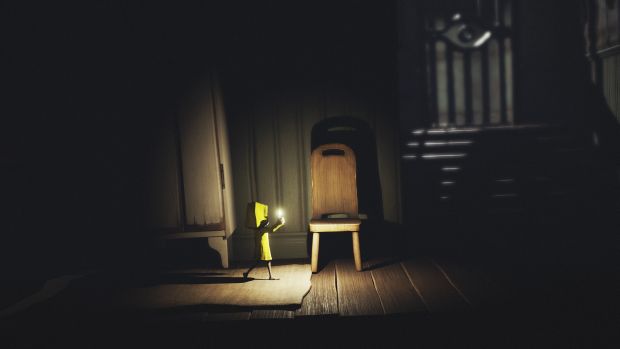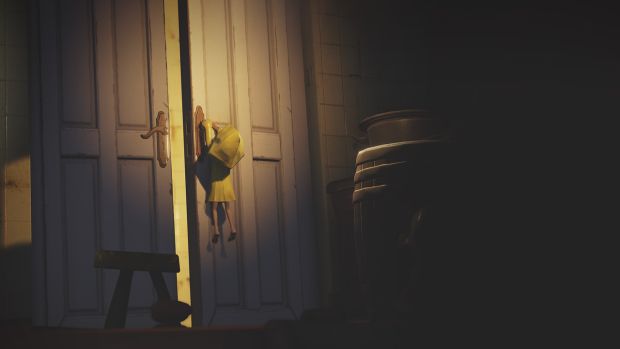
Living in a child’s world is never easy, especially when everything can appear ten times more terrifying. For Six, the protagonist of Tarsier’s Little Nightmares, it’s even tougher. After being kidnapped and taken to The Maw, Six embarks on a hard journey to escape. But can she handle what’s in store?
GamingBolt spoke to Tarsier’s Dave Mervik to find out more about the game, how it exaggerates things to craft a whole vision for them and much more.
"The Maw began life as a wonderful piece of concept art and a dream of where all the worst things in the world could be left to rot."
Little Nightmares‘ essence has been stated to be “exaggeration”, which is interesting given how intrinsic and non-verbal much of the story is. How did this desire to express exaggeration come about when first developing the game?
It comes from two main places really. First of all, it is a stylistic approach driven by our Art Director, who likes to find the core purpose or personality of things, isolate the elements that comprise this identity, and then amplify, twist, and distort them until they take on a new life of their own. The other reason is that we wanted to create a world that could almost have been reported by a child. If you listen to a kid recounting an event, it’s just full of energy and hyperbole, and things are always bigger, faster, stronger and larger-than-life. It’s the kind of world that we wanted to work with, and one that works perfectly with the vision of the Art Team.
The Maw, the world in which Little Nightmares is set, looks impressive in its depth and overall aesthetic. What are they key themes defining the Maw and how do they relate to the inner psyche of the child protagonist?
The Maw began life as a wonderful piece of concept art and a dream of where all the worst things in the world could be left to rot. From this starting point, we evolved and refined the concept, and weaved it together with this idea of a child’s perspective, bringing in ideas such as food horror, parasites, childhood games, and primal fears to create a complex web of influences that made The Maw what it is. In terms of how these themes relate to the main character, life can be a place of wild extremes at that age. It’s monsters or heroes, adventure or terror, playground or prison. That’s the kind of thing we wanted to explore in The Maw. It should be a place where you don’t know what’s around the next corner. It might be the worst thing you can imagine, or the most fun you’ve ever had, or a weird mix of the two.
What kinds of enemies or creatures will players encounter throughout Little Nightmares? Are there friendly NPCs present as well?
I think you’ve already seen the kind of characters you’re going to encounter, so I’m not going to spoil any further surprises. The friendliest characters you’re likely to meet are The Nomes, but I wouldn’t say they’re particularly nice; they’re just nice-er!

"The balance between fast pace and platforming versus slow pace and stealth has been a big challenge."
Is there a fixed linear design to the levels or are players free to explore as they choose? Are there any interesting things – like lore or notes and such – that can be discovered?
Yes, the game heads in one direction, rather than a more free-form world design, as we wanted to create a very strong first-time experience and we felt that this was the best way to achieve it. The lore itself is part of the world; small rich details that, for eagle-eyed players, are the first steps towards understanding the kind of world that would give birth to a place like The Maw.
There are heavy stealth mechanics defining Little Nightmares. What are some of the challenges you faced in crafting a stealth experience but from a platforming perspective?
The balance between fast pace and platforming versus slow pace and stealth has been a big challenge. The scale difference between Six and the world and characters of The Maw helps us to create challenging gameplay experiences that also feel natural. It makes it possible to use the environment in interesting ways, to hide or climb on furniture, and even if walking on the top of a shelf is high up for Six, it doesn’t necessarily mean you’re out of reach of danger.
What are some of the puzzles that players will face in the Maw? Is there a sense of discovery when trying to find the solution or are they fairly straightforward?
Puzzle solving is varied in complexity, though often simple. However even if the solution may be simple, it will require the player to explore the environment to discover what it is.
While the goal is to not take inspiration from other properties, do you feel the aesthetics of Little Nightmares will automatically be familiar to many players, thus affecting the story they project into the proceedings?
That’s a hard question to answer, since – in terms of aesthetics – I don’t know what people will compare this to. The one we hear most often is Tim Burton, but I just don’t see the similarity myself, and it’s certainly not something that we’ve ever courted. Everyone brings their own cultural touchstones though, so unless you actively set out to mimic someone else’s work, it’s not something you’re really in control of. For me, Little Nightmares has its own identity, and hopefully once more people get to see it, they’ll come into the experience with their eyes wide open.

"You can race through it in maybe a few hours, but you’ll miss out on all the nice details and atmosphere."
What are your thoughts on the resurgence of smaller platforming experiences but releasing across multiple big consoles (like Inside, Unravel, etc.)? Do you think Little Nightmares fills a unique requirement in this day and age?
I think we’re one of a growing band that doesn’t think high quality has to mean a long play time. What we’re seeing entering the mainstream now are a lot more games focusing on achieving their ambitions, regardless of how long it takes to get there. Inside is a magnificent example. Did it need gazillions of polygons; 60 hours play time, 120 person online multiplayer? The answer is obviously no, because they knew their game, what they wanted to achieve and how best to do it. Of course, everyone can’t always do it as well as Playdead, but they’ve shown it can be done differently, and that can do a hell of a lot to energise other developers with similar aspirations. If you want to keep evolving and showing that games are capable of more, you need to be bold, try new things, and express yourself.
How long will the entire experience be? Are there different endings or secrets for players to discover?
I think that depends on how you play really. You can race through it in maybe a few hours, but you’ll miss out on all the nice details and atmosphere. At a rough guess, I’d say somewhere in the region of 4-6 hours. In terms of the ending, there is just one, but what you make of that ending might differ among different players.
Earmarked for Spring 2017, when exactly can we expect Little Nightmares to release?
I’m afraid I can’t be any more ‘exact’ than that at this point.
With the PS4 Pro, Sony have increased the memory bandwidth a little bit, but they have kept the overall memory pool the same as it is on standard PS4 systems. Is this a fair trade off? Or do you foresee RAM becoming a bottleneck for game development as we move further on with this generation?
The bandwidth is a potential issue, especially when running 4k, but it’s probably a thought-through trade-off that they found necessary to make.
The PS4 Pro has double the GPU power of the original. What kind of advantages this has bought in for developers?
The extra GPU power is necessary for running games at 30 fps or higher in 4k. That’s probably the goal that Sony had in mind for the games released for the Pro.

"With time, developers usually find a way to get the most out of the consoles in one way or another."
Do you think Nintendo Switch being less powerful than PS4 and Xbox One will matter in the long run for the new console?
Hardware power hasn’t really mattered for Nintendo in a long while. It didn’t matter for the Wii and it’s likely not the reason why the Wii-U didn’t do as well. The accessibility of the product, the Nintendo games and the dedication from third-party developers is going to matter a lot more. The Switch is doing its own thing and it has potential to do well, both as a full or secondary alternative to Sony and Microsoft consoles.
6 TFLOPs naturally means that the Xbox One Scorpio has an extremely powerful GPU. Assuming that the rest of the specs also see similar or comparable bumps, what are the kinds of graphical improvements developers will be able to deliver on Scorpio?
We’ll hopefully get some really beautiful games running at a high frame rate in 4k. That would be a nice high bar for others to try to follow.
The Xbox One Scorpio is being touted as the most powerful console ever made. And yet, given Microsoft’s diktat that all games have maintain parity with standard Xbox One systems, and that there can be no Scorpio exclusives, do you really think that the Scorpio’s power will be able to be put to any meaningful use?
Initially, we’ll probably see less of a boost than we’d hope for, but there are ways to improve the games for Scorpio without sacrificing the experience of the game on Xbox One. With time, developers usually find a way to get the most out of the consoles in one way or another.















